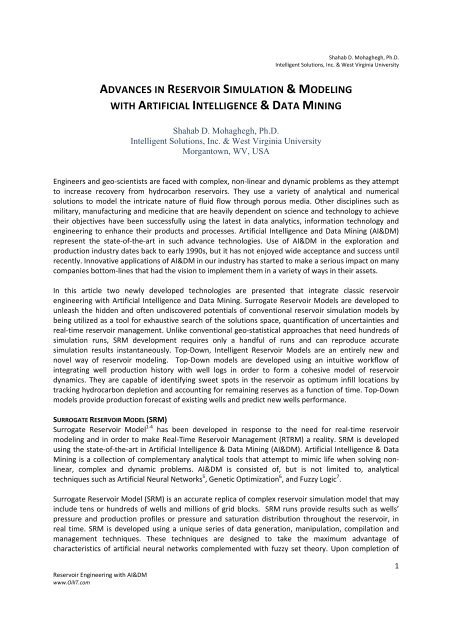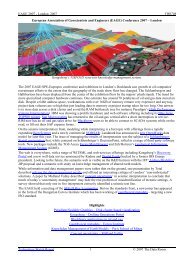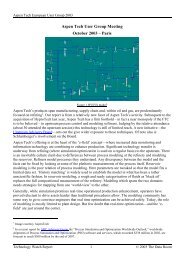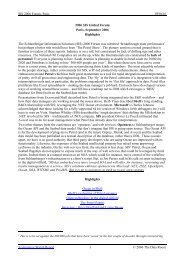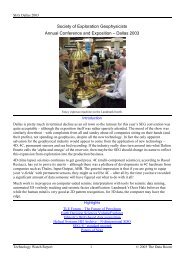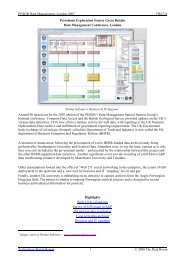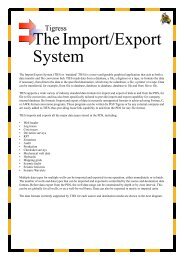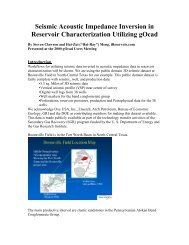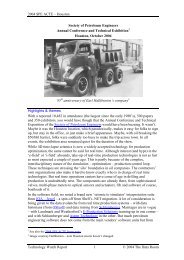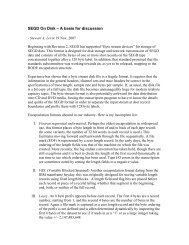Shahab D. Mohaghegh, Ph.D. Intelligent Solutions, Inc. & West
Shahab D. Mohaghegh, Ph.D. Intelligent Solutions, Inc. & West
Shahab D. Mohaghegh, Ph.D. Intelligent Solutions, Inc. & West
You also want an ePaper? Increase the reach of your titles
YUMPU automatically turns print PDFs into web optimized ePapers that Google loves.
<strong>Shahab</strong> D. <strong>Mohaghegh</strong>, <strong>Ph</strong>.D.<br />
<strong>Intelligent</strong> <strong>Solutions</strong>, <strong>Inc</strong>. & <strong>West</strong> Virginia University<br />
ADVANCES IN RESERVOIR SIMULATION & MODELING<br />
WITH ARTIFICIAL INTELLIGENCE & DATA MINING<br />
<strong>Shahab</strong> D. <strong>Mohaghegh</strong>, <strong>Ph</strong>.D.<br />
<strong>Intelligent</strong> <strong>Solutions</strong>, <strong>Inc</strong>. & <strong>West</strong> Virginia University<br />
Morgantown, WV, USA<br />
Engineers and geo‐scientists are faced with complex, non‐linear and dynamic problems as they attempt<br />
to increase recovery from hydrocarbon reservoirs. They use a variety of analytical and numerical<br />
solutions to model the intricate nature of fluid flow through porous media. Other disciplines such as<br />
military, manufacturing and medicine that are heavily dependent on science and technology to achieve<br />
their objectives have been successfully using the latest in data analytics, information technology and<br />
engineering to enhance their products and processes. Artificial Intelligence and Data Mining (AI&DM)<br />
represent the state‐of‐the‐art in such advance technologies. Use of AI&DM in the exploration and<br />
production industry dates back to early 1990s, but it has not enjoyed wide acceptance and success until<br />
recently. Innovative applications of AI&DM in our industry has started to make a serious impact on many<br />
companies bottom‐lines that had the vision to implement them in a variety of ways in their assets.<br />
In this article two newly developed technologies are presented that integrate classic reservoir<br />
engineering with Artificial Intelligence and Data Mining. Surrogate Reservoir Models are developed to<br />
unleash the hidden and often undiscovered potentials of conventional reservoir simulation models by<br />
being utilized as a tool for exhaustive search of the solutions space, quantification of uncertainties and<br />
real‐time reservoir management. Unlike conventional geo‐statistical approaches that need hundreds of<br />
simulation runs, SRM development requires only a handful of runs and can reproduce accurate<br />
simulation results instantaneously. Top‐Down, <strong>Intelligent</strong> Reservoir Models are an entirely new and<br />
novel way of reservoir modeling. Top‐Down models are developed using an intuitive workflow of<br />
integrating well production history with well logs in order to form a cohesive model of reservoir<br />
dynamics. They are capable of identifying sweet spots in the reservoir as optimum infill locations by<br />
tracking hydrocarbon depletion and accounting for remaining reserves as a function of time. Top‐Down<br />
models provide production forecast of existing wells and predict new wells performance.<br />
SURROGATE RESERVOIR MODEL (SRM)<br />
Surrogate Reservoir Model 1‐4 has been developed in response to the need for real‐time reservoir<br />
modeling and in order to make Real‐Time Reservoir Management (RTRM) a reality. SRM is developed<br />
using the state‐of‐the‐art in Artificial Intelligence & Data Mining (AI&DM). Artificial Intelligence & Data<br />
Mining is a collection of complementary analytical tools that attempt to mimic life when solving nonlinear,<br />
complex and dynamic problems. AI&DM is consisted of, but is not limited to, analytical<br />
techniques such as Artificial Neural Networks 5 , Genetic Optimization 6 , and Fuzzy Logic 7 .<br />
Surrogate Reservoir Model (SRM) is an accurate replica of complex reservoir simulation model that may<br />
include tens or hundreds of wells and millions of grid blocks. SRM runs provide results such as wells’<br />
pressure and production profiles or pressure and saturation distribution throughout the reservoir, in<br />
real time. SRM is developed using a unique series of data generation, manipulation, compilation and<br />
management techniques. These techniques are designed to take the maximum advantage of<br />
characteristics of artificial neural networks complemented with fuzzy set theory. Upon completion of<br />
Reservoir Engineering with AI&DM<br />
www.OilIT.com<br />
1
<strong>Shahab</strong> D. <strong>Mohaghegh</strong>, <strong>Ph</strong>.D.<br />
<strong>Intelligent</strong> <strong>Solutions</strong>, <strong>Inc</strong>. & <strong>West</strong> Virginia University<br />
modeling process and validation, SRM can accurately replicate the results generated by highly<br />
sophisticated reservoir simulation models in response to changes made to the model input, in fractions<br />
of a second. The fact that thousands of SRM runs can be performed in seconds makes uncertainty<br />
analysis a practical task. This allows the uncertainty band associated with any decisions to be identified<br />
quickly. It takes only a handful of simulation runs to generate the required data to develop a SRM.<br />
SRM has been successfully field‐tested and peer‐reviewed. In a recent study performed on a giant oil<br />
field in the Middle East, a SRM was developed to replicate the existing simulation model of the field that<br />
was developed using a commercial simulator. Consisting of approximately a million grid blocks, the<br />
computing time required for a single run of the existing simulation model is 10 hours on a cluster of 12<br />
parallel CPUs. Upon development, calibration and validation of the SRM that could successfully and<br />
accurately replicate the results of the simulation model, tens of millions of SRM runs were performed in<br />
order to comprehensively explore the reservoir model’s solution space so a successful field<br />
development strategy could be developed. The objective was to increase oil production from the field<br />
by relaxing the rate restriction that was imposed on wells. The key was to identify those wells that<br />
would not suffer from high water cuts once a rate relaxation program was put into place. The SRM had<br />
to take into account and quantify the uncertainties associated with the geological model while<br />
accomplishing the objectives of this project.<br />
Figure 1. Results of lifting rate restriction on typical wells from clusters 1 and 5.<br />
Upon completion of tens of millions of SRM runs (equivalent to tens of millions of simulation runs) the<br />
165 wells in the field were divided into 5 clusters, based on the risk of rising water cuts. It was<br />
recommended that wells in clusters 1 and 2 be subjected to rate relaxation. Furthermore, it was<br />
predicted that these wells would produce small amount of water and large amount of incremental oil in<br />
the next 25 years. On the other hand, more than 100 wells placed in clusters 4 and 5 were identified as<br />
wells that will produce large amounts of water if the rate restrictions were lifted.<br />
Upon completion of the study, rate restriction was lifted from 20 wells. These wells were selected from<br />
among all the clusters to provide a representative spatial distribution of the reservoir and examine the<br />
accuracy of the SRM predictions. After more than two and a half years of production the results were<br />
analyzed. As can clearly be seen from Figure 1 (similar results observed from all other wells in the<br />
corresponding clusters as summarized in Figure 2), wells in clusters 1 and 2 produced large amounts of<br />
incremental oil while the water production declined. The opposite effect was observed in wells that<br />
were classified in clusters 4 and 5, as predicted by the SRM. Figure 2 shows the maximum incremental<br />
water cut normalized for all wells in each of the clusters. It is clear from this figure that in accordance<br />
Reservoir Engineering with AI&DM<br />
www.OilIT.com<br />
2
<strong>Shahab</strong> D. <strong>Mohaghegh</strong>, <strong>Ph</strong>.D.<br />
<strong>Intelligent</strong> <strong>Solutions</strong>, <strong>Inc</strong>. & <strong>West</strong> Virginia University<br />
with the SRM’s predictions water cut decreased in wells classified in clusters 1 and 2 while increasing<br />
significantly in wells classified in clusters 4 and 5.<br />
Results shown in the above study as well as other similar studies demonstrate the robustness of SRM<br />
technology. SRM can be used to develop replicas of sophisticated and large reservoir simulation models<br />
that can then be used in order to drive the main engine of Real Time Reservoir Management (RTRM).<br />
Figure 2. Percent increase in maximum water cut normalized for all wells in clusters 1 through 5.<br />
TOP‐DOWN, INTELLIGENT RESERVOIR MODELING<br />
Traditional reservoir simulation and modeling is a bottom‐up approach. It starts with building a<br />
geological model of the reservoir followed by adding engineering fluid flow principles to arrive at a<br />
dynamic reservoir model. The dynamic reservoir model is calibrated using the production history of<br />
multiple wells and the history matched model is used to strategize field development in order to<br />
improve recovery.<br />
Top‐Down <strong>Intelligent</strong> Reservoir Modeling approaches the reservoir simulation and modeling from an<br />
opposite angle by attempting to build a realization of the reservoir starting with well production<br />
behavior (history). The production history is augmented with core, log, well test and seismic data in<br />
order to increase the accuracy and fine tune the Top‐Down model. The model is then calibrated (history<br />
matched) using the most recent wells as blind dataset. Although not intended as a substitute for the<br />
traditional reservoir simulation of large, complex fields, this novel approach can be used as an<br />
alternative (at a fraction of the cost and time) to traditional reservoir simulation in cases where<br />
performing traditional modeling is cost (and man‐power) prohibitive. In cases where a conventional<br />
model of a reservoir already exists, Top‐Down <strong>Intelligent</strong> Reservoir Modeling should be considered a<br />
complement to, rather than a competition for the traditional technique. It provides an independent look<br />
at the data coming from the reservoir/wells for optimum development strategy and recovery<br />
enhancement. Top‐Down <strong>Intelligent</strong> Reservoir Modeling provides a unique perspective of the field and<br />
Reservoir Engineering with AI&DM<br />
www.OilIT.com<br />
3
<strong>Shahab</strong> D. <strong>Mohaghegh</strong>, <strong>Ph</strong>.D.<br />
<strong>Intelligent</strong> <strong>Solutions</strong>, <strong>Inc</strong>. & <strong>West</strong> Virginia University<br />
the reservoir using actual measurements. It provides qualitatively accurate reservoir characteristics that<br />
can play a key role in making important and strategic field development decisions.<br />
AN ALTERNATIVE TO CONVENTIONAL MODELING<br />
Top‐Down <strong>Intelligent</strong> Reservoir Modeling starts with well‐known reservoir engineering techniques such<br />
as Decline Curve Analysis, Type Curve Matching, History Matching using single well numerical reservoir<br />
simulation, Volumetric Reserve Estimation and calculation of Recovery Factors for all the wells<br />
(individually) in the field. Using statistical techniques multiple Production Indicators (3, 6, and 9 months<br />
cumulative production as well as 1, 3, 5, and 10 year cumulative oil, gas and water production and Gas<br />
Oil Ratio and Water Cut) are calculated. These analyses and statistics generate a large volume of data<br />
and information that are spatiotemporal snap shots of reservoir behavior. This large volume of data is<br />
processed using the state‐of‐the‐art in artificial intelligence and data mining in order to generate a<br />
complete and cohesive model of the entire reservoir. This is accomplished by using a set of discrete<br />
modeling techniques to generate production related predictive models of well behavior, followed by<br />
intelligent models that integrate the discrete models into a cohesive picture and model of the reservoir<br />
as a whole, using a continuous fuzzy pattern recognition algorithm.<br />
Top‐Down <strong>Intelligent</strong> Reservoir Model is calibrated using the most recent set of wells that have been<br />
drilled in the field. The calibrated model is then used for field development strategies to improve and<br />
enhance hydrocarbon recovery.<br />
DETAILS AND AN EXAMPLE OF TOP‐DOWN MODELING<br />
Top‐Down Modeling is an elegant integration of state‐of‐the‐art in AI&DM with classic reservoir<br />
engineering techniques and principles. It provides a unique perspective of the field and the reservoir<br />
using actual measurements. It provides qualitatively accurate reservoir characteristics that can play a<br />
key role in making important and strategic field development decisions.<br />
Table 1. Number of wells starting<br />
production in each of the years.<br />
One of the most important<br />
advantages of Top‐Down modeling<br />
is its ease of development. It is<br />
Reservoir Engineering with AI&DM<br />
www.OilIT.com<br />
Figure 3. Generating the Voronoi cells for the wells in the Carthage<br />
field, Texas.<br />
4
<strong>Shahab</strong> D. <strong>Mohaghegh</strong>, <strong>Ph</strong>.D.<br />
<strong>Intelligent</strong> <strong>Solutions</strong>, <strong>Inc</strong>. & <strong>West</strong> Virginia University<br />
designed so that an engineer or a geologist with a Bachelor’s degree will be able to comfortably develop<br />
a Top‐Down model in a relatively short period of time with minimum amount of data. The disadvantage<br />
of Top‐Down modeling is that it cannot be performed on “any” field. It is designed for fields that have at<br />
least 50 wells and about 5 to 7 years of production.<br />
Figure 4. Results of discrete predictive modeling showing the distribution of first 3 months and 5 year cum.<br />
production for the entire field.<br />
Location and monthly production rate data for all wells and well logs (not necessary for all wells) are the<br />
minimum data requirement for the Top‐Down modeling. Figures 3, 4 and 5 present a short summary of<br />
the processes used to complete a Top‐Down model. These figures are related to a Top‐Down modeling<br />
study that was performed on part of Carthage field in Texas that included 349 wells. These wells were<br />
drilled from 1986 to 1995. Table 1 shows the number of wells that were drilled on any given year since<br />
1986. Figure 3 shows the well locations, followed by identification of boundary and the Voronoi grids for<br />
all the wells in the analysis. Once the Decline Curve Analysis and other steps that were mentioned above<br />
were completed, the discrete modeling and fuzzy pattern recognition are performed. The distribution of<br />
first three months of production as well as the 5 year cumulative production are (results of discrete<br />
predictive modeling) shown in Figure 4.<br />
Reservoir Engineering with AI&DM<br />
www.OilIT.com<br />
5
<strong>Shahab</strong> D. <strong>Mohaghegh</strong>, <strong>Ph</strong>.D.<br />
<strong>Intelligent</strong> <strong>Solutions</strong>, <strong>Inc</strong>. & <strong>West</strong> Virginia University<br />
Figure 5. Results of Fuzzy Pattern Recognition showing the sweet spots in the field for the first 3 months<br />
(left) and 5 year cum. production (left).<br />
Figure 5 shows the results of fuzzy pattern recognition. The sweet spots in the field are shown with the<br />
dark brown color. The Relative Reservoir Quality (RRQ) is indicated by the colors in this figure. Higher<br />
quality of the reservoir are indicated with darker color. Figure 5 shows the depletion in the reservoir as<br />
the sweet spot shrinks between 3 months and 5 years (from left to right). This provides an indication of<br />
depletion and a guide on where to drill the next wells in this field.<br />
REFERENCES<br />
1. <strong>Mohaghegh</strong>, S.D. et al. Development of Surrogate Reservoir Model (SRM) for Fast Track Analysis<br />
of a Complex Reservoir. International Journal of Oil, Gas and Coal Technology. February 2009,<br />
Volume 2, Number 1. pp 2‐23.<br />
2. Development of Surrogate Reservoir Models (SRM) For Fast Track Analysis of Complex<br />
Reservoirs. <strong>Mohaghegh</strong>, S. D., Modavi, A., Hafez, H. , Haajizadeh, M., Kenawy, M., and<br />
Guruswamy, S., SPE 99667, Proceedings, 2006 SPE <strong>Intelligent</strong> Energy Conference and Exhibition.<br />
11‐13 April 2006, Amsterdam, Netherlands.<br />
3. Quantifying Uncertainties Associated with Reservoir Simulation Studies Using Surrogate<br />
Reservoir Models. <strong>Mohaghegh</strong>, S. D.SPE 102492, Proceedings, 2006 SPE Annual Conference &<br />
Exhibition. 24‐27 September 2006, San Antonio, Texas.<br />
4. Uncertainty Analysis of a Giant Oil Field in the Middle East Using Surrogate Reservoir Model.<br />
<strong>Shahab</strong> D. <strong>Mohaghegh</strong>, <strong>West</strong> Virginia U. & <strong>Intelligent</strong> <strong>Solutions</strong>, <strong>Inc</strong>., Hafez Hafez, ADCO, Razi<br />
Gaskari, WVU, Masoud Haajizadeh, ADCO and Maher Kenawy, ADCO. SPE 101474, Proceedings,<br />
2006 Abu Dhabi International Petroleum Exhibition and Conference. Abu Dhabi, U.A.E., 5‐8<br />
November 2006.<br />
5. Virtual Intelligence Applications in Petroleum Engineering: Part 1; Artificial Neural Networks.<br />
<strong>Mohaghegh</strong>, S. D., Journal of Petroleum Technology, Distinguished Author Series. September<br />
2000, pp 64‐73.<br />
6. Virtual Intelligence Applications in Petroleum Engineering: Part 2; Evolutionary Computing.<br />
<strong>Mohaghegh</strong>, S. D., Journal of Petroleum Technology, Distinguished Author Series. October 2000,<br />
pp 40‐46.<br />
7. Virtual Intelligence Applications in Petroleum Engineering: Part 3; Fuzzy Logic. <strong>Mohaghegh</strong>, S. D.,<br />
Journal of Petroleum Technology, Distinguished Author Series. November 2000, pp 82‐87.<br />
8. <strong>Intelligent</strong> Production Data Analysis, <strong>Intelligent</strong> <strong>Solutions</strong>, <strong>Inc</strong>. Morgantown, <strong>West</strong> Virginia, USA.<br />
http://www.<strong>Intelligent</strong><strong>Solutions</strong><strong>Inc</strong>.com<br />
9. The Voronoi Web Site: http://www.voronoi.com/wiki/index.php?title=Main_Page<br />
Reservoir Engineering with AI&DM<br />
www.OilIT.com<br />
6


